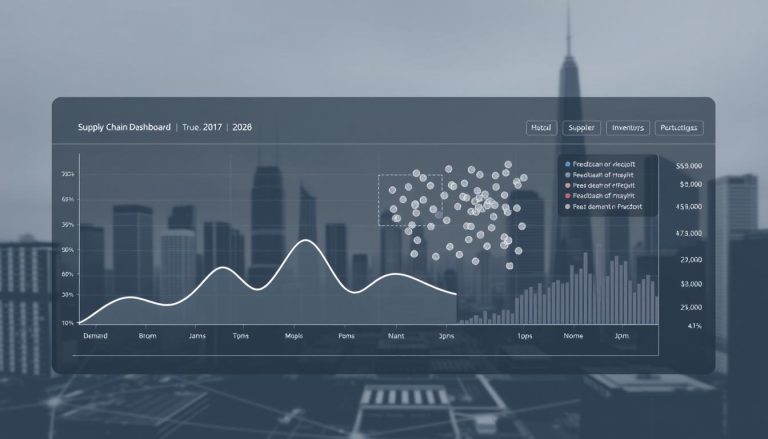Optimize Your Forecasting and Demand Management
Volatile demand and long lead times put a strain on budgets and service levels in U.S. supply chains. This article provides a practical framework for forecasting and demand management. It’s designed for decision-makers to apply immediately. It balances methods, data quality, and process design to turn forecasts into tangible business results.
The analysis combines insights from McKinsey, Gartner analyst Tim Payne, and recent benchmarks. It clarifies what drives effective demand forecasting. It shows where forecasting strategies offer the most benefit and how to choose demand forecasting tools that grow with complexity.
The emphasis is on execution: better data, appropriate models, and decisions backed by data. Readers will get guidance on various methods, from time-series to causal and machine learning. There’s also advice on handling seasonality, cyclicality, and life cycle shifts.
The coverage includes strategies for aggregation, time buckets, and shifting from accuracy-only metrics to uncertainty-aware planning. This is a guide for leaders who aim to enhance service, reduce inventory, and free up working capital. It focuses on effective demand forecasting and the right tools.
Why Forecasting Accuracy Matters for Inventory and Customer Satisfaction
Accurate projections are key to managing stock, capacity, and labor effectively. By employing demand forecasting techniques and disciplined models, we can minimize waste and service risks. In unpredictable markets, precise forecasting provides a solid foundation for decision-making, allowing for flexibility and quick adjustments.
Right-sized inventory and resource allocation
Forecasting demand helps align purchase orders, production, and warehouse space with actual needs. This approach reduces waste and service risks. In volatile markets, it ensures decisions are grounded while allowing for flexibility and rapid updates.
Retailers that account for seasonality and cycles in their forecasting avoid systematic errors. This leads to better capacity planning, avoiding unnecessary buffers. As a result, cash is freed up, and operations can maintain high throughput during busy periods.
Customer experience impact from stockouts and overstocks
Stockouts can lead to lost sales and customer churn, while overstocks waste resources and increase the risk of obsolescence. Accurate demand forecasting strikes a balance, ensuring fast-moving items are always available without overstocking slow movers.
By combining forecasting with real-time data, such as POS and marketplace information, businesses can adapt quickly to changing patterns. This approach ensures consistent service levels and reduces the need for split shipments and backorders.
Linking forecast quality to service levels and working capital
High-quality forecasts enable precise safety-stock management and reliable replenishment cycles. This results in stable service levels with lower inventory, improving cash flow. Forecasting that incorporates uncertainty ranges helps manage service-risk tradeoffs, guiding decisions on buffer placement.
Validating forecasting models against market inputs allows for reduced lead-time variability and lower expediting costs. Effective demand forecasting supports both customer satisfaction and financial discipline.
| Operational Metric | Impact of Higher Forecast Accuracy | Business Outcome | Relevant Practice |
|---|---|---|---|
| Safety Stock | Reduced for same target service level | Lower carrying costs and less markdown risk | Inventory demand forecasting with seasonality and cycle factors |
| Fill Rate / On-Shelf Availability | Fewer stockouts and backorders | Higher conversion and repeat purchase | Effective demand forecasting with near-real-time POS signals |
| Resource Utilization | Smoother labor and capacity plans | Less overtime and fewer expedites | Demand forecasting techniques embedded in S&OP |
| Working Capital | Lower average inventory and faster turns | Improved cash conversion cycle | Forecasting models with uncertainty ranges for buffer optimization |
Key Challenges in Demand Forecasting to Address Early
Data inaccuracy and limited availability are major hurdles. Incomplete or unreliable historical data hampers parameter estimation and model stability. Rapid product changes and frequent launches disrupt baselines. Using proxy data and pilot runs helps stabilize early signals for new SKUs.
Explicit controls for seasonality and cyclicality, like seasonal indexing and cyclical analysis, reduce bias and prevent drift. This ensures more accurate forecasting.
Overreliance on historical data is risky in fast-changing markets. External factors like macroeconomic indicators, competitor actions, and weather data often explain variance that history cannot. Effective strategies blend inputs and focus on disciplined feature selection to avoid noise.
Model complexity is another challenge. Highly complex algorithms can be error-prone and difficult to understand, increasing operational risk. Simple, transparent methods like exponential smoothing or ARIMA often perform better in real-world scenarios. Teams should choose demand forecasting tools based on data maturity and ensure they are easy to interpret.
Organizational silos hinder consensus planning. Collaboration between sales, supply chain, and finance is essential to update assumptions with new data. Research from McKinsey and Gartner’s Tim Payne highlights the limitations of deterministic plans under volatility and structural breaks. Embedding uncertainty early and identifying variability sources support robust forecasting and demand management.
Practical steps include routine data audits and documented seasonal factors. Scenario ranges help frame risk. Adopting demand forecasting tools requires clear governance and measurable outcomes. For new products, using proxy curves and short pilot studies calibrates expectations while keeping broader strategies adaptable.
Continuous refresh cycles ensure forecasts stay aligned with market signals. As models ingest new data, planners should test sensitivity to various factors. This approach links demand forecasting methods to decision speed, ensuring accountability and transparency.
Building Better Data Foundations for Forecasting Models
Reliable inputs are essential for reliable outputs. A strong focus on data discipline is key to scaling forecasting strategies across various brands, channels, and regions. Teams that manage data as a governed asset experience faster forecasting cycles and better demand management. They also make the most of demand forecasting techniques and tools.
Data governance and routine data audits
Assign clear ownership for sales, POS, promotions, lead times, and supply constraints. Document the data’s origin from systems like SAP, Oracle, and Salesforce to the modeling layer. Establish controls for calendars, units, and price effects to avoid data drift.
Monthly audits are vital to identify anomalies, backorders, and calendar misalignments that distort baselines. Use audit logs and exception reports to track changes. These steps ensure forecasting strategies are grounded in reality, aligning with operational needs.
Data enrichment and external data integration
Improve data quality by incorporating macro indicators from the Bureau of Labor Statistics, weather data from NOAA, and competitive moves from retail media. Social sentiment streams are also valuable. Real-time data ingestion supports demand forecasting that responds to local events and promotions.
Integrate enriched data into pipelines that power demand forecasting tools. Ensure versioned feature stores, latency SLAs, and bias checks. This approach prepares datasets for both baseline models and rapid promotional lifts.
Handling missing, sparse, or noisy historical data
For new items and thin SKU-location histories, leverage hierarchies at brand or category levels. Use proxy analogs from comparable launches by firms like Procter & Gamble or Nestlé to seed priors. Seasonal indexing helps correct periodic gaps and stabilize variance.
Pilot tests in select markets can generate early demand curves and refine priors. Combine outlier filters with robust statistics to manage noise. These strategies enhance demand forecasting techniques and improve the performance of demand forecasting tools in broader forecasting and demand management workflows.
Choosing Demand Forecasting Methods and Forecasting Models
Model selection significantly impacts service levels, costs, and response speed. The choice must align with the depth of data, its volatility, and the decision-making timeframe. A strategic approach combines statistical models with expert insights, supported by demand planning software for accountability and traceability.
Time-series options: moving average, exponential smoothing, ARIMA
Time-series methods transform historical data into a predictive baseline. Moving averages are effective for stable products, filtering out noise. Exponential smoothing, including Holt-Winters, captures trends and seasonality with minimal parameters. ARIMA extends these capabilities for items with autocorrelation and seasonal patterns, critical when error structures are complex.
These models are quick to update and scale well. They offer transparent outputs, essential for effective demand forecasting during periods of limited promotions and mix changes. Many demand planning software solutions from SAP and Oracle incorporate these methods for routine use.
Judgment-based methods for new products and disruptive markets
In data-scarce or rapidly changing environments, structured judgment is essential. This involves combining market research, competitive analysis, and customer feedback. Techniques like Delphi panels and pre-mortems enhance judgment accuracy and consistency.
These methods are critical for launching new products and managing short product lifecycles. They ensure traceability through clear documentation and regular review. Demand planning software records assumptions for future evaluation.
Causal and regression analysis for promotions, price, and macro factors
Causal analysis isolates the impact of price changes, promotions, and macroeconomic factors on demand. A/B tests and geo-lifts validate cause-and-effect relationships. This supports the creation of precise promotion calendars and price strategies.
Regression models analyze multiple drivers simultaneously, enabling sensitivity analysis. They guide resource allocation and media mix decisions, complementing time-series models. When integrated into forecasting models, they enhance demand forecasting across various channels.
Machine learning for pattern discovery and non-linear dynamics
Machine learning excels in uncovering complex, non-linear patterns across different items, stores, and regions. Techniques like gradient boosting, random forests, and recurrent neural networks adapt as data volumes increase. These methods are ideal for environments where relationships are dynamic and interactions are complex.
Ensuring robust features and high-quality data is critical. Demand planning software provides governance, explainability tools, and champion-challenger testing to maintain model accuracy and usability in daily operations.
- Selection criteria: interpretability needs, data readiness, volatility, and decision latency.
- Operating model: automate the baseline, layer causal drivers, and formalize judgment gates.
- Maintenance: schedule re-tuning, monitor drift, and track error by segment and horizon.
Seasonality, Cyclicality, and Product Life Cycle Considerations
Seasonal indexing and cyclical analysis help turn recurring peaks and troughs into measurable inputs for forecasting strategies. Retailers see surges in November–December, while construction softens in winter. Ignoring these cycles introduces bias and skews inventory demand forecasting. Baselines should reflect multi-year patterns, with separate profiles for regions where holidays differ.
During major events such as Christmas, Chinese New Year, and back-to-school, combine causal drivers with seasonal baselines. Promotions, price changes, and media spend alter lift factors that demand forecasting techniques must capture. Weekly detail can track intra-month patterns, but monthly buckets often deliver clearer signals and less noise when seasonality dominates.
Product life cycle stage dictates parameter choices within forecasting models. At launch, use proxy items, pilot markets, or Bayesian priors to stabilize sparse data. In growth, ramp plans should incorporate distribution gains and marketing cadence. Maturity favors stabilized error bands and steady service levels. In decline, taper forecasts and align end-of-life plans to avoid obsolescence.
Frequent product refreshes and technology shifts can outdate prior fits. Conduct routine model re-estimation and re-tuning to maintain fidelity. Rolling reviews keep elasticity, seasonality strength, and cycle length current. This discipline supports capacity planning and safety stock calibration, reducing peak-season stockouts and off-peak excess.
Operations teams benefit from clear rules that link seasonal strength and life cycle stage to stocking and labor plans. The matrix below summarizes practical signals and actions that integrate demand forecasting techniques with inventory demand forecasting.
| Pattern or Stage | Primary Signals | Recommended Forecasting Strategies | Preferred Forecasting Models | Inventory Actions |
|---|---|---|---|---|
| Strong Seasonality | High seasonal index, low off-season demand | Use seasonal decomposition with causal overlays for events | Holt-Winters (additive/multiplicative), SARIMA | Increase safety stock pre-peak; reduce rapidly post-peak |
| Cyclicality | Multi-year macro cycles, category-wide swings | Blend macro indicators with lag structures | ARIMAX, dynamic regression, state-space | Stage capacity and adjust reorder points to cycle phase |
| Introduction | Sparse sales, pilot or proxy item data | Analog-based seeding with expert inputs | Hierarchical Bayesian, Croston for intermittent | Conservative buys, short review cycles |
| Growth | Rising demand, new distribution, marketing lift | Ramp curves with causal drivers | Gradient boosting or ETS with trend, dynamic regression | Phase-in capacity; increase safety stock where lead times are long |
| Maturity | Stable volume, predictable seasonality | Stabilize parameters and monitor drift | Exponential smoothing with seasonality, SARIMA | Optimize reorder points to service targets |
| Decline | Downward trend, cannibalization, discontinuation plans | Decay curves and step-down adjustments | Piecewise regression, damped-trend ETS | Run-down inventory; minimize returns and write-offs |
| Intra-Month Patterns | Weekly spikes tied to pay cycles or promotions | Use weekly buckets when patterns are consistent | TBATS or Prophet with holiday effects | Fine-tune replenishment frequency and labor scheduling |
| High Noise Environments | Volatile demand, irregular promotions | Aggregate to monthly for signal clarity | Kalman filter state-space, robust regression | Buffer stock with dynamic review intervals |
Cadence matters. Monthly buckets often absorb volatility better than weekly, improving the clarity of seasonal signals. Shift to weekly only when recurring intra-month patterns affect service or capacity. These practices integrate inventory demand forecasting with event calendars and production plans.
Consistent parameter reviews, backtests, and bias checks keep demand forecasting techniques aligned with current market behavior. Lifecycle-aware settings and disciplined updates ensure forecasting models remain responsive while avoiding overfitting during short-lived spikes.
Aggregation, Disaggregation, and Time Buckets for Reliable Forecasts
Creating reliable plans requires the right level of detail and timing. Teams must align aggregation choices with decision horizons. They should also match time buckets to supply and promotion cycles. Strong governance ensures forecasting strategies are aligned with clear rules on when to roll up or drill down.
When category-level aggregation improves signal-to-noise
Category rollups can stabilize inventory demand forecasting by leveraging the law of large numbers. Larger pools help mute one-off anomalies, revealing seasonality and trends. This is beneficial when SKU histories are short, such as after a new launch at Target or Walmart.
Use top-down signals to seed item estimates. Then, apply demand forecasting methods that borrow strength across similar products. Tools from SAP Integrated Business Planning and Oracle Fusion Cloud support this approach with hierarchical models.
SKU-location and customer-level disaggregation for actionability
Operations need item and site detail for effective action. Disaggregation to SKU-location enables precise allocation and smarter replenishment. It aligns stock to local demand without inflating inventory.
Customer-level views expose profit concentration and growth pockets. Retailers using Salesforce or Microsoft Dynamics 365 can segment accounts. They can target service levels and tune forecasting strategies for priority groups while limiting spend on low-yield segments.
Monthly versus weekly buckets and when to go granular
Monthly buckets are efficient and stable for inventory demand forecasting. They smooth intra-month order shifts and reduce analyst workload. They also pair well with demand forecasting methods that model seasonality and product life cycles.
Weekly buckets add precision when supply is tight, promotions repeat on weekly cycles, or logistics capacity is constrained. Demand forecasting tools like Amazon Forecast and SAS enable mixed frequencies. This lets planners switch cadence by product or region.
Choose granularity based on decision impact, data quality, and cost to maintain. This keeps forecasting strategies practical while preserving signal.
| Planning Choice | Primary Benefit | Best Use Case | Typical Tools | Risk if Misapplied |
|---|---|---|---|---|
| Category Aggregation | Higher stability, clearer trend | New SKUs, sparse history, noisy demand | SAP IBP, Oracle Cloud SCM | Masks item-level outliers that matter operationally |
| SKU-Location Disaggregation | Actionable allocation and replenishment | Regional variability, store-specific demand | Blue Yonder Luminate, Kinaxis RapidResponse | Overfitting to noise, excess effort across long tails |
| Customer-Level Disaggregation | Service-level and margin prioritization | Key accounts, differentiated SLAs, promotions | Salesforce, Microsoft Dynamics 365 | Complexity without material revenue impact |
| Monthly Buckets | Efficiency and robust seasonality capture | Stable demand, longer lead times, portfolio planning | SAS, Anaplan | Missed weekly cycles and short promo effects |
| Weekly Buckets | Greater precision for short-cycle decisions | Tight capacity, weekly promos, perishables | Amazon Forecast, IBM Planning Analytics | Resource intensity and higher noise sensitivity |
Across these choices, combine inventory demand forecasting with fit-for-purpose demand forecasting methods. Support planners with demand forecasting tools that handle hierarchies and mixed frequencies. Align forecasting strategies to the decisions that protect service and working capital.
From Accuracy-Only to Uncertainty-Driven and Probabilistic Planning
Volatile demand, structural breaks, and complex supply networks diminish the value of point estimates. McKinsey and Gartner’s Tim Payne advocate for a shift to uncertainty-led practices. These practices acknowledge error as a constant. They rely on effective demand forecasting, enabled by forecasting models that quantify variance. These models guide resilient decisions.
Why deterministic planning falls short in volatile environments
Deterministic plans assume a single future, locking inventory and capacity to a fixed number. Yet, when promotions fail, suppliers miss slots, or demand surges, these plans falter. Probabilistic forecasting strategies, on the other hand, map ranges around expected values. This allows teams to adjust safety stock, buffers, and expediting policies in anticipation of shocks.
Scenario ranges, forecast distributions, and service-risk tradeoffs
Teams should evaluate full forecast distributions, not just mean values. Utilizing demand forecasting tools from vendors like ToolsGroup, Oracle, or SAP IBP, planners can compare service levels, stock investment, and margin across various scenarios. This clarifies the service-risk tradeoff, enabling adaptive reorder points.
Scenario ranges support tiered policies: critical SKUs target higher service, while long-tail items run leaner. This approach enhances effective demand forecasting by linking inventory to probability, not hope. It aligns forecasting models with capacity, transportation constraints, and lead-time variability.
Digital twins to test resilience and response options
Digital supply chain twins simulate demand volatility and supply shocks before execution. Planners test levers—dual sourcing, safety stock rules, and lead-time buffers—then select actions that minimize lost sales and expedite costs. Gartner highlights resilience metrics such as time to survive and recovery time as key readiness gauges.
When combined with advanced demand forecasting tools, these twins assess mitigation across probable futures, not just one baseline. The goal is to achieve robust outcomes through practical forecasting strategies. These strategies must scale across markets and seasons while safeguarding service and shareholder returns.
Cross-Functional Collaboration and Governance
Communication failures between sales, marketing, and supply management can severely impact forecasts. Establishing a governed cadence ensures these groups align with common demand signals and clear decision-making authority. Through joint reviews, teams convert market data into actionable demand forecasts. This supports service levels and maintains financial discipline.
Consensus is achieved by blending model outputs with insights from account teams and category managers. During significant market shifts, like the rise in home-office equipment demand, weekly reviews replaced monthly ones. This change helped avoid outdated assumptions. Assigning ownership to each forecast, with clear roles in commercial, operations, and finance, ensures accuracy and continuous improvement.
Structured S&OP and IBP processes formalize roles, inputs, and escalation procedures. Meeting agendas focus on variance drivers, error tracking, and model selection reviews. Documenting the rationale behind forecasts keeps stakeholders informed and facilitates quick responses to demand changes.
Demand planning software from SAP, Oracle, and Kinaxis enhances workflow, version control, and scenario governance. These tools integrate forecasting and demand management with policy rules, audit trails, and user permissions. They improve handoffs from planning to procurement and production.

External collaboration enhances signal quality. In retail, CPFR with partners like Walmart and Procter & Gamble shares POS trends, promotion calendars, and constraints. This collaboration reduces latency and stabilizes replenishment, enabling effective demand forecasting across the network.
To foster discipline, organizations implement a closed-loop process. This involves defining ownership, gathering inputs, running models, validating with field intelligence, deciding, and measuring. This loop embeds forecasting and demand management into daily operations. Demand planning software enforces checkpoints and records decisions for audit and learning.
Industry-Specific Approaches and Demand Planning Software
Different sectors require unique strategies in demand forecasting. Effective demand planning software must integrate both internal and external data. It should also support causal models and machine learning. Plus, it needs to foster collaboration and scenario planning with clear audit trails.
Retail: POS data, loyalty insights, CPFR, and inventory demand forecasting
Retailers use point-of-sale data, loyalty insights, and basket analysis to spot trends. They apply Collaborative Planning, Forecasting and Replenishment (CPFR) to align with suppliers. This reduces delays and the risk of stockouts.
Software from SAP, Oracle, and Blue Yonder combines store, e-commerce, and promotion data. It forecasts size-color-level inventory. These tools model price elasticity and markdown effects, simulating vendor lead times to meet service goals.
Healthcare: EHR-enabled forecasting and simulation
Health systems forecast patient volumes using EHR data from Epic and Oracle Health. They link clinical pathways with supply usage rates. This anticipates surges in medications, PPE, and sterile kits.
Discrete-event simulation and queueing models test staffing and bed capacity. Inventory demand forecasting improves with seasonality, RSV and flu trends, and local event data.
Manufacturing: ERP integration and JIT support
Manufacturers integrate forecasts with ERP suites like SAP S/4HANA, Oracle Cloud ERP, and Microsoft Dynamics 365. This drives MRP, capacity planning, and supplier schedules. Tight coupling is key for lean and Just-in-Time operations, reducing buffers.
Advanced demand forecasting techniques combine causal drivers, engineering change signals, and service-part failure rates. Demand forecasting tools generate distribution-based plans. These plans align safety stocks with target service levels across plants and warehouses.
Energy: Weather-linked analytics and grid demand forecasting tools
Utilities use weather-linked analytics to manage variability from solar and wind. Grid operators apply short-term load forecasts using temperature, cloud cover, and DER telemetry. This stabilizes dispatch and reduces imbalance costs.
Vendors like GE Vernova, Siemens, and IBM embed probabilistic models and digital twins. These stress-test peak events. Demand planning software supports probabilistic outputs for service-risk optimization in trading, supply, and network operations.
| Industry | Core Data Inputs | Primary Techniques | Software Focus | Business Outcome |
|---|---|---|---|---|
| Retail | POS, loyalty, basket, promo calendars, supplier data | Elasticity modeling, halo analysis, CPFR, ML classification | Omnichannel forecasting, price/promo optimization, vendor collaboration | Higher on-shelf availability with lower overstocks |
| Healthcare | EHR encounters, acuity, seasonality, local epidemiology | Time-series with causal factors, simulation, queueing | Supply-use linkage, surge planning, bed and staff modeling | Fewer stockouts of critical items and smoother throughput |
| Manufacturing | ERP orders, BOMs, lead times, maintenance and failure data | Hybrid causal-ML, intermittent demand models, ABC-XYZ | MRP alignment, capacity synchronization, supplier scheduling | Reduced buffers and improved schedule adherence |
| Energy | Weather forecasts, DER telemetry, market prices, grid constraints | Probabilistic load models, scenario analysis, digital twins | Short-term load forecasting, outage planning, risk controls | Lower imbalance penalties and improved reliability |
When choosing demand planning software, look for explainability, scalability, and external data integration. It should also support generating forecast distributions. These features ensure that inventory demand forecasting and cross-functional planning operate with measurable risk controls across each sector.
Verify native support for causal modeling, machine learning, and scenario simulation when evaluating demand planning software. Balanced use of demand forecasting tools and techniques enables actionable plans. These plans align service targets with cost and risk.
Best Practices for Effective Demand Forecasting Execution
Execution is key to turning analysis into tangible results. Teams that effectively blend demand forecasting with strict governance excel in unpredictable markets. They use forecasting strategies that align models, processes, and accountability. These strategies are updated as market conditions change.
Combine various demand forecasting methods with models that incorporate both internal data and external signals. This includes weather, macroeconomic indicators, and retail sales data. It’s important to maintain buffers for unpredictable variability and to regularly update models with exception-based reviews.
Continuous validation with market insights and consensus
Set up a monthly routine to align statistical forecasts with current market insights from sales, finance, and supply. Include data from Nielsen, IRI, the Bureau of Labor Statistics, and the National Weather Service when applicable.
Conduct consensus checks to resolve discrepancies between system outputs and field inputs. Document each discrepancy, its cause, and the corrective actions taken. This ensures continuous improvement in forecasting and planning.
Explainable, measurable forecasts with clear ownership
Require that forecasting models produce transparent outputs. Stakeholders should understand the factors influencing the forecast, such as level, trend, seasonality, promotions, and price changes. Publish model explanations that link these factors to specific actions, like adjusting safety stock or prices.
Assign clear ownership for each forecasting horizon. Define roles for approving changes, monitoring bias, and updating parameters. Record errors at each cycle to maintain credibility.
KPIs for error, resilience, time-to-survive, and recovery time
Monitor accuracy and robustness together. Use metrics like MAPE, weighted MAPE, and bias for error. Add resilience metrics to evaluate performance across different scenarios. Set clear targets for each product class and lead time.
Use KPIs to trigger policy updates, including reorder points, safety stock, and service targets. Feed diagnostics back into forecasting strategies to refine demand forecasting methods and enhance effective demand forecasting capability.
| KPI | Definition | Decision Trigger | Primary Owner | Applicable Horizons |
|---|---|---|---|---|
| MAPE | Mean absolute percentage error by SKU-location | Exceeds threshold for 2 cycles | Demand Planner | Weekly to monthly |
| Bias | Signed error indicating systematic over/under forecast | |Bias| above target for 1 cycle | Planning Lead | Weekly to quarterly |
| Time to Survive | Duration current inventory can meet demand without replenishment | Below lead time for critical items | Supply Manager | Daily to weekly |
| Recovery Time | Time to restore target service after a disruption | Exceeds service policy limit | Operations Director | Monthly to quarterly |
| Probability of Execution | Likelihood the plan can be fulfilled under scenario set | Drops below agreed threshold | S&OP Chair | Monthly |
| Refresh Cadence Adherence | On-time model retraining and parameter updates | Missed event or late cycle | Analytics Lead | Weekly to monthly |
Implement a closed-loop process: diagnose errors, update parameters, adjust policies, and document outcomes. This ensures forecasting models align with operational constraints and delivers measurable results.
As markets evolve, update forecasting strategies with machine learning where beneficial. Maintain human oversight. Keep demand forecasting methods transparent, measurable, and owned. This enables decisions to scale with speed and rigor.
Forecasting and Demand Management
Effective demand forecasting starts with governance. It’s essential to establish data ownership and conduct regular audits. This ensures data consistency across ERP, CRM, and POS systems. Adding weather signals, economic indicators, and mobility trends enriches internal records.
Keeping platforms updated is critical. Demand forecasting tools and models must reflect market changes and policy shifts. This ensures accurate forecasting.
Choose forecasting strategies that align with your decision-making needs. Combine time-series methods for stable baselines with causal and regression analysis for promotions and price changes. Machine learning is useful for non-linear effects, and judgment is necessary for new product launches or supply shocks.
Granularity is key. Use hierarchical aggregation to stabilize noisy categories and then disaggregate for detailed action. Align time buckets with volatility and cadence. This approach strengthens forecasting and demand management.
Forecasting should include ranges, not just points. Produce probabilistic forecasts and define service-risk trade-offs. Track resilience KPIs like fill rate and recovery time. Digital twins help stress-test scenarios and evaluate buffers.
Institutionalize validation and ownership. Run backtests and forecast-value-added analysis. Assign owners for each hierarchy node and cadence. Refresh tools with real-time signals and recalibrate models as AI advances.
Apply domain-specific practices. In retail, combine POS, loyalty data, and CPFR with suppliers. In healthcare, link EHR simulations to seasonality and public health advisories. In manufacturing, integrate ERP and MES for JIT while maintaining buffers. In energy, couple weather-linked analytics with grid demand forecasting tools.
Maintain prudent buffers that recognize model limits and lead-time variability. Update signals, parameters, and exception rules regularly. With disciplined execution, these strategies align teams, reduce errors, and ensure reliable supply decisions.
Conclusion
Effective forecasting and demand management hinge on disciplined data stewardship, suitable forecasting models, and robust governance. Teams that prioritize data accuracy, seasonality, and product life cycles create a reliable signal. Cross-functional routines, involving sales, operations, and finance, ensure decisions are based on shared facts.
Sector-specific practices and real-time analytics, including AI for pattern detection, enhance speed and precision. This approach maintains oversight. A diverse toolkit of demand forecasting methods—ranging from time-series to machine learning—supports accurate forecasting. Execution demands continuous market validation, clear assumptions, and ownership of metrics like MAPE and bias.
Transitioning from accuracy-focused to uncertainty-driven planning is critical. Scenario ranges and digital twins quantify risk and response options, aligning with McKinsey and Gartner’s advice. Metrics like time-to-survive and recovery time help leaders balance service and risk, ensuring resilience in volatile markets.
Organizations that combine strong data practices, fitting forecasting models, and collaborative governance achieve reliable outcomes. By adding probabilistic planning, they optimize inventory, customer service, and cash flow. This approach scales from routine to disruption, marking the path to enduring demand forecasting success.
FAQ
How does forecast accuracy improve inventory demand forecasting and customer service?
Accurate forecasts align inventory targets with expected demand. This reduces safety stock, freeing up working capital. It also boosts on-shelf availability and order fill rates.
By integrating seasonality and cyclicality, systematic misses are prevented. This directly improves customer satisfaction.
What are the most common challenges to effective demand forecasting and how should teams address them?
Data inaccuracy and sparse histories are major obstacles. Rapid product churn and overreliance on historical patterns also hinder efforts. Establishing data governance and running audits can help.
Enrich signals with external drivers like macro indicators and weather. Cross-functional governance and regular updates reduce bias and keep planning current.
Which demand forecasting methods and forecasting models are most useful in practice?
Time-series models like moving averages and ARIMA are effective for level, trend, and seasonality. Judgment-based inputs are useful for launches or structural breaks. Causal and regression analysis quantify price and promotion effects.
Machine learning is beneficial for non-linear pattern detection when data is sufficient. Choose methods based on data readiness, interpretability, and operational use.
How should teams model seasonality, cyclicality, and product life cycle dynamics?
Apply seasonal indexing and cyclical analysis for predictable peaks and troughs. Adjust for life cycle stages: introductions, growth, maturity, and decline. Combine seasonal baselines with causal signals for events and holidays.
When is aggregation or disaggregation the right strategy, and how should time buckets be chosen?
Aggregate at category or brand level for stability with noisy or short histories. Disaggregate to SKU-location or customer level for allocation and replenishment. Monthly buckets are often better for signal-to-noise ratio.
Use weekly granularity for intra-month cycles or when promotions require precision.
Why shift from accuracy-only to uncertainty-driven and probabilistic planning?
In volatile markets, deterministic planning underperforms. Probabilistic methods evaluate forecast distributions and scenario ranges. This enables service-risk tradeoffs and robust inventory policies.
Digital twins allow teams to stress-test safety stock and lead-time buffers. This supports resilience KPIs like time to survive and recovery time, as recommended by McKinsey and Gartner’s Tim Payne.
What data practices strengthen forecasting strategies and demand planning software outcomes?
Define ownership, lineage, and controls for sales and supply constraints. Conduct audits to catch anomalies and calendar misalignments. Enrich with external variables like economic data and weather.
For sparse data, use hierarchical borrowing and proxy analogs. Clean, granular datasets enable probabilistic outputs and digital twin experiments in modern demand planning software.
How do sector-specific approaches change the forecasting playbook?
Retail benefits from POS feeds and loyalty insights. Healthcare leverages EHR-linked models for patient volumes. Manufacturing relies on ERP integration for JIT precision.
Energy uses weather-linked analytics for renewable variability management.
What execution practices ensure effective demand forecasting and demand management?
Build a disciplined cadence with continuous validation and explainability. Assign clear ownership for each forecast. Add resilience metrics like time to survive and recovery time.
Use exception-based reviews to drive parameter and policy updates.
Which demand planning software capabilities matter most for reliable forecasts?
Prioritize platforms that integrate internal and external data. Support a range of forecasting strategies and models. Produce probabilistic forecasts.
Look for scenario planning, explainability tools, and digital twin capabilities. Scalability, data governance features, and collaboration workflows are essential for effective demand forecasting at scale.







